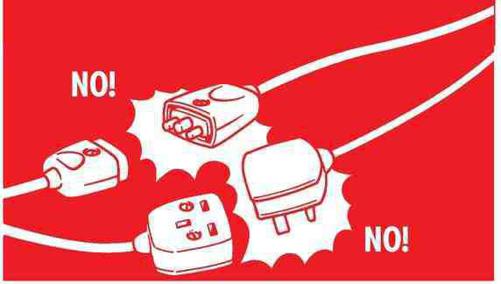SAS Urban Survival Handbook (13 page)
Read SAS Urban Survival Handbook Online
Authors: John Wiseman
Tags: #Health & Fitness, #Reference, #Survival, #Fiction, #Safety, #Self-Help, #Personal & Practical Guides, #General, #Survival Skills

REMEMBER
Always use the flex grips on plugs to hold the flex. Make sure ALL the flex, including the outer sheath, is held. NEVER pull plugs out of their sockets by the flex.
MISWIRING A PLUG
 DANGER! Miswiring a plug, by swapping the live and neutral wires, is extremely dangerous. The fuse in the plug is totally ineffective, because the live wire is not connected to it.
DANGER! Miswiring a plug, by swapping the live and neutral wires, is extremely dangerous. The fuse in the plug is totally ineffective, because the live wire is not connected to it.
Normally, what happens when a table lamp (for instance) is switched off, is that the switch breaks the circuit—stopping the live current at the switch. When the live and neutral wires are swapped, the switch effectively breaks the neutral wire and the lamp appears to behave correctly—by going off. However, all you have done is to cut off the return path for the electricity, so that the current cannot flow.
THE LAMPHOLDER IS STILL LIVE! A slip when changing the bulb could lead to ELECTROCUTION.
Old wiring
Wiring circuits should be checked at least every 20 years. Old wiring can be recognized by primitive bakelite plugs and fittings, fabric-covered flex hanging from ceiling fittings and more than one fuse box.
In Britain two-pin sockets and plugs should be replaced with modern three-pin 13-amp fittings, when rewiring is done. Replacing the sockets alone is not good enough.

WARNING
Keep all flexes and leads as short as possible. Many falls and accidents are caused by tripping over trailing flexes! Taping cable to the floor is a temporary safety measure, but you should consider installing new sockets where you actually want to use the equipment.
Adaptors
Overloading a socket with an adaptor which can take several other plugs is NOT safe. Worse still, other adaptors may be joined on, allowing still more plugs to be fitted! Not only will you overload the socket electrically, but literally as well. The adaptor will work loose in the socket from the sheer weight of plugs and flexes. This can weaken electrical connections. Exposed pins may be touched, risking electrocution. Have you got enough sockets to avoid this?
Extension leads
If you have to use extension leads inside your house, either you have not got enough sockets or the arrangement of furniture and appliances means that your sockets are in the wrong positions. Multi-socket extension leads are undoubtedly safer than adaptors, but:
- ◑
DON’T
leave the lead coiled when in use. It will generate heat and possibly start a fire. - ◑
DON’T
use the sockets if there is any sign of charring anywhere, even on the flex. - ◑
DON’T
get portable sockets wet. - ◑
DON’T
exceed the 3000-watt maximum that the socket on the wall could cope with.
Extension leads that bring power from sockets to hard-to-reach places like lofts or gardens, temporarily, should be made of a flex suitable for the power consumption and the length of run involved.
Some cheap multi-socket extension leads have been found to be extremely dangerous. If any problem occurs, discontinue use.
REMEMBER
If you must extend the wiring on an appliance, NEVER join two wires by simply twisting the ends together—even if you bind the join with electrical insulating tape. THIS IS UNSAFE. Use proper shielded protectors or junction boxes. Even an in-line switch means that a new piece of flex could be joined on. It is preferable to fit a new longer flex. Since this means opening the appliance and tampering with it, consult an expert.

WARNING
If a two-part connector or a plug/socket extension is used to extend a flex, NEVER NEVER NEVER arrange this so that the live flex ends with the exposed pins. It must end with the socket. If outdoors temporarily, wrap the connection in polythene for protection against moisture. NEVER pull on an extended flex whilst in use. If you do, go back and check the connection.

KITCHENS AND BATHROOMS
The kitchen with its numerous gadgets and the power-hungry oven creates a greater demand for electricity. Consider installing a separate circuit. There is also the presence of water to consider—electricity and water are a very dangerous combination. Some gadgets, such as irons, are handled a lot and flexes and connections can wear out.
In bathrooms, the main danger is the presence of water and the metal sanitary fittings, even if you’re only temporarily using power tools. Protect yourself with an RCD/RCB/ELCB. Both rooms deserve special consideration, electrically speaking (see ROOM CHECK: Kitchens and Bathrooms).
OUTDOOR CIRCUITS
If you require electricity outside the house for a garage, greenhouse, lighting or a water pump, proper weatherproof exterior fittings and cables must be used.
All outdoor wiring should be fitted with RCDs/RCBs/ ELCBs, which should protect you immediately if a fault develops.
External wall lights
Porch lights can be run from the household supply, but the exposed wiring must be protected by a conduit. All connections MUST be weatherproof. The lamp inside the fitment must be protected by a rubber skirt or cup which prevents contact with the connections.
Electricity for outbuildings
Supplies to outbuildings may be run off the domestic supply.
They can be carried overhead (up to 5m/15ft):
Provide posts and a support wire (galvanized catenary wire). The wire should slope slightly to encourage water to run off it. At the lower end the cable should have some slack arranged as a drip-loop to prevent water following the cable all the way to the end connections. Keep overhead cables above head height and be aware of the possibility of wind damage.
They can also be carried underground (over 5 m/ 15 ft):
Cables must be armoured (such as MICS—mineral insulated copper sheathed) and run in a strong conduit. They should be run at the base of walls and fences if possible—or buried low enough to avoid damage from digging.
The outdoor supply should be earthed, both from the main earth connection at the meter/consumer unit and also in the outbuilding. The circuit should be fitted with an RCD/RCB/ ELCB. If the use of the outbuilding involves the need for more than one light and one socket, it should be fitted with its own fuse box/consumer unit.
Garden sockets
It is possible to fit sockets in the garden, preferably in a sheltered location. Two main kinds of socket are available (and which claim to be weatherproof). One has a hinged plastic cover which protects the socket when not in use. The other has a screw-on cover—each plug that fits into it also has a cover fitted round the flex. WHEN the plug is inserted, the cover is screwed onto the socket, covering the plug.
OTHER OPTIONS
Low-voltage installations
Consider low-voltage lighting—even in the garden. Not only does it use a lot less power, it also works on such low voltages that there is no danger of electrocution from the fittings. It has become common to use low-voltage lighting in shops, in gardens and (more recently) in homes. Low-voltage pumps are also available for garden ponds and fountains.
Generally speaking, the mains supply is reduced by a transformer. If used for outdoor lighting, the transformer must be kept in the house, garage or outbuilding.
Lighter cables may be used in conduits on walls, or buried—sleeved in a length of ordinary garden hosepipe. It is still important to check that all connections are weatherproof.

WARNING
A transformer should be properly housed and subjected only to the loads specified by the manufacturer. Transformers generate heat while operating—even those which plug into a socket to operate electronic equipment. Ensure adequate ventilation and switch them off when not in use.
Cordless devices
More and more cordless devices are available. These are mainly irons and kettles. There is a base unit which is plugged into a socket and carries full mains power. The ‘cordless’ appliance only receives power when it’s sitting in the base unit. The very nature of these types of equipment means that a careful eye should be kept on them for signs of wear and tear, especially if water is involved. Follow safety instructions.
Rechargeable devices such as power tools, food mixers, electric screwdrivers—even electric toothbrushes—are cordless when in use, but must be returned to their recharging units. Check carefully for wear and tear. DON’T try to use the recharging unit for anything except the tool it was intended for.
